

The AirmailCollectingGuide provided in these pages is also available downloadable.
![]()
James W. Graue
One could make a winning case for aviation as the greatest achievement of the 20th century. With flight came the instant realization that with it went communications. Freed from the inherent constraints of all modes of surface travel, communications transported by air- airmail – provided a quantum leap in the advance of mail delivery, and with it the pace of all facets of human life.
Airmail is the philatelic and postal historical reflection of the development of aviation and its effect on world communications. Consider the development of aviation itself and one can find it reflected in the mail that was flown:
The path the limited flights of the pioneers, with special demonstration flights sanctioned to carry souvenir “airmail,” whose successes inspired the development of aircraft in all forms, becoming increasingly fast, range-capable, and reliable, thereby making possible the air carriers, from regional to national, international, intercontinental, and transoceanic; and at every step, from the hesitant first to the confident final, there was – airmail!
Airmail, the actual flown documents, is the foundation of aerophilately. It was not always the standard that it is today, but a premium service requiring the payment of special postage rates, often reflected in the airmail stamps that have been issued world-wide since early in the game. Special airmail markings applied to the airmail, the transit times reflected in dispatch and arrival postmarks, and the airmail postage rates all indicate the means of flight and the route taken. The world for the airmail collector is as wide and deep as one wishes to make it. The choice is unlimited. Consider . . .
The world of airmail, all of which is a product of less than one century, offers the collector almost limitless choice. Much of it is yet untapped, still waiting to challenge the initiative and creativity of an airmail collector – an aerophilatelist!
For further insights into this fascinating world of philately, read on.

Taking off with the mail in Washington, D.C. on May 15, 1918. (National Postal Museum, Smithsonian Institution)
![]()
Jonathan L. Johnson, Jr.
Cover collecting is a wide open field and an extension of stamp collecting. A “cover” is an envelope that has seen postal service. Many have “cachets,” a rubber stamped or printed impression or label placed on the cover descriptive of the event for which it was mailed. Collecting airmail covers can be as inexpensive as the price of postage to service pictorial cancellations or as expensive as the purchase price of a famous rarity, such as a piece of surviving Hindenburg crash mail. Start with a limited objective, pick a category, and collect. You may change your direction along the way or discover new airmail areas of interest.
Routes, rates, cities, states, countries, first days, special events, pilot autographs, and markings are all desirable areas of cover collecting. Some covers may be flown, while others may note a special event, such as an airport dedication. Covers for your collection may be found in dealer stocks at stamp exhibitions and bourses, by mail from established dealers, in club and public philatelic auctions, in exchange with other collectors, and through ads in the philatelic press. Joining the American Air Mail Society is a way to obtain information on these sources.
Postal history or commercial airmail cover collecting is an enjoyable aspect of the hobby. Here you can learn routes, rates, and how airlines developed. The American Air Mail Catalogue provides resource information as well as potential areas of interest. The many AAMS publications, chapters, and study groups are all ready to help you and receive your input as you study stamps and markings on airmail covers.
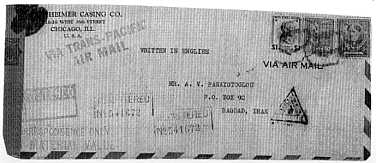
Cover posted July 7, 1941, Chicago, flown to San Francisco, placed on board one of the Pan American Airways flying boats, and flown to Singapore on FAM Route 14. It then was flown to Baghdad, Iraq by either a British or Dutch airline, arriving on August 6. It was censored in India, bearing both a censor handstamp and censor tape sealed with wax. Franked at $1.55 for twice the rate of 70¢ per 1/2 ounce + 15¢ registry fee.
![]()
Kent J. Kobersteen
Airmail stamps can provide a fascinating, aesthetically pleasing, historically informative topic for the collector. You can build a collection of airmail stamps which is as broad as a single copy of every airmail stamp which has been issued worldwide, or as narrow as a specialized look at a single series or a single issue. Airmail postcards, stationery, and aerogrammes provide yet another area of specialization.
A collection of worldwide airmail stamps will show not only the development of aircraft and air-related events, but also will show how the airmail service developed worldwide. So too, will the collection of a single country’s airmail issues tell the story of the development of airmail in that country. In the case of the United States, for instance, the development of the airmail both domestically and internationally, and the rates for this service, can be traced through a collection of U.S. airmail stamps.
You can also specialize in a single series, such as the U.S. Transport issue of the early 1940s, or a single stamp such as the Beacon airmail stamp of 1928. At first glance you might assume such specialization would limit your collecting options. Quite the contrary. After avidly collecting the Beacon airmail stamp for over fifteen years, one continually finds new material in usages on covers and in an extensive representation of the stamps.
A first step in building such a specialized collection of a single issue or series is to consult catalogues and specialized literature. The American Air Mail Catalogue, Scott’s Specialized U.S. Stamp Catalogue, and Max G. Johl’s The United States Postage Stamps of the Twentieth Century, Volume III, will indicate plate positions, recuts, varieties, and errors which have been found by other specialists. Many aerophilatelists have published works based on their research; a search of the philatelic literature will reveal new information in a variety of areas. It is extremely gratifying to make a discovery that has been overlooked by earlier experts.
You might begin with the design itself, researching its origins. Essays of some stamps may be on the market, others exist only in the archives of the Bureau of Engraving and Printing in Washington, D.C.
Mint stamps can be obtained showing various plate positions, guide lines, plate numbers, and other marginal markings, as well as sideographer and plate finisher’s initials – – if they occur on the issue being studied.
It is also important to learn about the appropriate printing and perforating processes to analyze production varieties of the stamp or stamps in question. As you look at more copies of the stamp, you will find slight variations due to production differences. The archives of the Bureau of Engraving and Printing contain a wealth of information about the production of United States issues.
Used copies of airmail stamps offer unusual and interesting cancellations with numerous possibilities: fancy cancels, slogan cancels, socked-on-the-nose cancels, numeral cancels, paquebot and foreign cancels — the list is nearly endless. You can also search for stamps with perforated insignia or perfins and precancels. Many pleasant hours can be had pouring over dealers’ stocks or large lots of relatively common stamps. And, when mounted, the display of various cancellation varieties can be impressive.
Once you feel you have exhausted the possibilities of your stamp study, keep looking, and examine other stamp exhibits for ideas of new directions to pursue. You can always find more fascinating material to add to your stamp collection, and through study and scholarship you can contribute to the overall body of knowledge of your specialty.
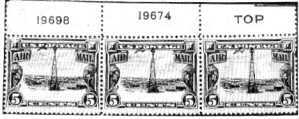
Inaccurate registration of vignette and frame printings created this example of a dramatic shift on the Beacon airmail stamp.
![]()
Basil S. Burrell
In addition to postage stamps on flown mail, you may discover other adhesives on cards or envelopes. Some collectors find this an intriguing specialty study area, as they seek mail with various etiquettes, air labels, and semi-official airmail stamps.
Etiquettes are government issued labels which are designed to be adhered to letters which shall be carried via airmail. Countries and post offices all around the world have issued these labels, as listed in Jones’ Etiquettes: Par Avion – By Airmail.
The original intent was to speed up the means of transport, over long or arduous routes. When the United States Government decided to fly all mail, if it deemed it to be more convenient and economical, the use of etiquettes became unnecessary except for international mail.
Air labels are labels, similar to etiquettes, that the air lines issue and give away to advertise their air line name and identify airmail letters.
When all mail went via air “when convenient,” the air lines decided these labels were an unnecessary expense, especially since the post office offered complimentary etiquettes. Therefore, most U.S. airline air labels are pre-1955.
The Aeronautica and Air Label Collectors Club, an AAMS chapter, has published the eight-volume Airtransport Label Catalog. Earlier works such as Muller’s Catalogue des Etiquettes Aeropostales and Field’s Aero Field Handbook of Airmail Labels would also provide resource information.
You can also find labels with an aviation theme issued privately and by various organizations for air shows, airport dedications, stamp shows, rocket mails, local posts, advertising, and other special events.
Semi-official airmail adhesives are government approved, but privately issued, stamps sold at post offices and designed to pay for the cost of air transport of mail. These letters, or covers, were required to have the regular surface government stamps to cover the cost of delivery. The private air lines then, with the pilot acting as a postman, carried the sacks of mail from post office to post office.
An example of this arrangement took place in Canada where long distances north of Winnipeg or Edmonton could be reached in a day by plane, while it might take two weeks by dog sled. There were 16 such companies that operated in Canada from 1924 to 1934.

United Air Lines promoted their service and identified airmail letters with this complimentary air label.
![]()
Dan Barber
For nearly seventy-five years airmail stamps and covers have appeared in more magazines, journals, monographs, and catalogues than most other philatelic specialties. Far beyond the usual listings of how many stamps were issued or how many covers were flown, a long succession of aerophilatelic scholars have pored over newspaper clippings, postal archives, airline timetables, aircraft registries, pilot biographies, and mountains of aeronautic and aviation publications.
Even before World War I the Aero Mail Club – the world’s first aerophilatelic organization – began a serialized reporting of United States pioneer flight covers in Percy McGaw Mann’s Philadelphia Stamp News, and later in The New England Philatelist. However, it was not until 1923 that England’s Aero Philatelic Club of London and the Aero Philatelic Society of America began to issue monthly mimeographed sheets to its first members.
Throughout the 1920s and 1930s a series of sometimes short-lived airmail groups added to the offerings with occasional magazines. But airmail journals and catalogues gained new visibility as the American Air Mail Society (AAMS) began its own publication series after 1931.
In 1926 Francis J. Field in England initiated a house organ, The Aero Field, that for nearly sixty years would cover an international scene of airmail stamps and covers, while several years later in the United States the AAMS rapidly increased its circulation of The Airpost Journal, which became its monthly magazine.
As aviation, airmail, and aerophilately developed, collectors cast about for every bit of paper about planes, pilots, stamps, and covers. An article about the latest exploit of Charles Lindbergh or Amelia Earhart became as intrinsic to aerophilately as the latest auction catalogue of Fred Kessler, Irwin Heiman, or Nicolas Sanabria.
Zeppelin brochures and airline timetables became as necessary as The Postal Bulletin. Every article about the most recent Boeing or Douglas aircraft was a fundamental reference; some aerophilatelists snapped up the rotogravure sections of newspapers or stopped in the local movie house for clips of the latest long-distance flight.
Aerophilately has long been a hobby devoted to a mass of literature about much more than stamps and covers. There are literature hounds who go after long runs of aviation magazines of the 1920s and 1930s, as well as scholars who study auction catalogues of a number of firms. And every time there is a new biography released on some early airmail pilot, an aerophilatelist somewhere will be searching for a copy. With the aerophilatelist the book store becomes nearly as important as the stamp show.
The usual stamp catalogues and airmail cover handbooks have been around – and will continue to appear – for many decades, but the dedicated aerophilatelist is much like an archaeologist, digging about for more information about airlines, pilots, planes, flights, and a host of other details that define a hobby with few boundaries.
The literature of aerophilately is sometimes more difficult to locate than the airmail stamps and covers that collectors continue to study. A set of the three 1930 United States Zeppelin stamps can be easily found and purchased, but only the devout airmail specialist will keep searching for that elusive aircraft book or aeronautic magazine with the definitive article.
Since 1940 the American Air Mail Society has been one of aerophilately’s most committed, and most successful, publishers, continuing a long tradition of journals, catalogues, and handbooks for specialized study. The future is still bright for aerophilatelic literature – there are still many airmail stories to be told. And collectors will forever seek the multitude of books and magazines that define a hobby quite undefinable.
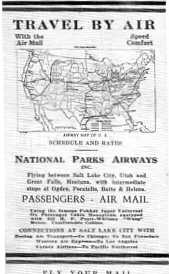
Timetables, such as this example from National Parks Airways, can be a great source of information on routes, schedules, and airmail rates.
![]() Download this Collecting Airmail Booklet
Download this Collecting Airmail Booklet
Cheryl Ganz
Note: See exhibits of “Jenny airmail 100 years”
Airmail collectors, or aerophilatelists, come from all walks of life throughout the world. They all share a passion for aviation and its impact on worldwide communications. Many are pilots, work in the aircraft industry, serve in aviation in the armed forces, or have other direct connections to flight. Others were stamp collectors as children and returned to philately, now seeking a specialty that offers new challenges and knowledge. Some are advanced philatelists of a specific country who wish to research the rates and usages of the airmail stamps of their area of specialization. Yet others began collecting coins or postcards or antiques and discovered that in airmail collecting there is a greater opportunity to meet fellow collectors, exhibit collections, write about discoveries, and share enthusiasm. Museum curators and aviation history buffs find new approaches to their subjects in aerophilately. Whatever influences you toward collecting airmail, you will find great rewards; this area of concentration offers plenty of room for you to create a specialization that is tied to your interests or pursuits. This is a hobby full of fun and great, creative people!
Collecting Airmail was designed to help you enter the field of airmail collecting by having leading American aerophilatelists write about their own collecting interests. The authors share a passion for aerophilately, and together we hope these essays offer an overview of airmail collecting and an inspiration to novice collectors seeking expanded horizons.
Have a great time as you pilot your way through Collecting Airmail. The contents in this guide offer only an introduction to the possibilities of airmail collecting. The sky is the limit! Use your imagination. The members of the American Air Mail Society hope to meet you soon during one of your layovers!
![]()
Preparing for Takeoff
Introduces you to the basics of airmail:
Setting the Clock
Provides an overview of the chronological time frames for this past century of flight:
Surveying the Map
Allows you to plot a course by geographical region, route, or airline:
Navigating the Aircraft
Exposes you to some of the means of transport that have become collecting areas of specialization:
Scanning the Horizons
Guides you to additional possibilities for exploration:
Safe Landing
Provides additional knowledge and resources
Collecting U. S. Air Mail and Other Flown First Day Covers
Professor C. R. (Bob) Helms, Ph.D.
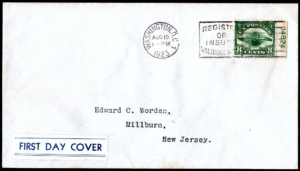
This collecting area is the intersection of two major collecting areas: air mail covers on the one hand, and first day covers on the other. First Day Cover (FDC) collecting is a broad area and well represented by the American First Day Cover Society (www.afdcs.org) and the discussion here will be limited specifically to air mail and other flown FDC’s, air mail date of rate change covers, or air mail first know use. Of particular interest are FDC’s that are also First Flight covers (FFC’s). I recall the great excitement I experienced years ago on finding that some C20 FDC’s were also FAM 14 first flights from San Francisco to Honolulu, Guam, and Manila, on November 11, 1935.
U.S. Air mail FDC’s.
Collecting FDC’s for air mail stamps in the U.S. spans the period from May 13, 1918 to January 20, 2012, when the USPS issued the last air mail stamp. We saw the last domestic air mail stamp issued on December 27, 1973, and in October 11, 1975, domestic air mail rates were “abolished.” All U.S. air mail stamps issued from January 2, 1974 – January 20, 2012, were for foreign mail.
The first known US air mail FDC is the (Scott #) C3, issued on May 13, 1918. Since the first flights associated with the C3 did not occur until the May 15th, the Postmasters held the covers in Washington, New York, or Philadelphia, so they could be flown on the 15th. Such covers for the C1 – C3 are exceedingly rare. The USPS issued the next series of US Air mail stamps, C4 – C6, in August of 1923. We show an example of a C4 plate number single FDC here (US FDC C4 Fig 1). Interestingly enough, the air mail rate at that time was only $0.02 and it is very unlikely this cover or others like it ever flew.
Subsequent issues of air mail stamps occurred at the beginning of the heyday of FDC collecting and cachet making. For example, Mellone’s Planty
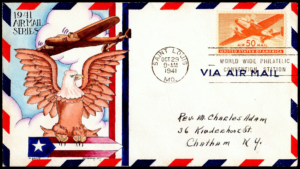
Photo Encyclopedia shows 25 different cachets for the C10, issued on June 18, 1927. Cachet makers made numerous copies of their FDC’s making them easily collectable on a reasonable budget. Some, of course, are quite rare and valuable such as the early Dorothy Knapp C31 FDC from 1941 shown here (US FDC C31 Fig. 2). Given they tell the story, not only of air mail history, but aviation history itself, the collecting area can be quite interesting and educational.
Flown U. S. Regular Mail FDC’s
May FDC cachet makers and collectors prepared covers for regular mail FDC’s on air mail envelopes with sufficient postage to be flown air mail. This is a relatively unexplored area of collecting that will likely lead to many “finds.” We show an example for a combination FDC of Scott #’s 551 and 576 (US FDC Fig. 3). A total of $0.08 is affixed which is the correct postage for the Government flights from New York to Chicago on April 4, 1925. Not shown is a backstamp in Chicago the next day. We show another example for the Kansas overprint stamps issued on May 1, 1930 (US FDC Fig. 4). This Scott # 658 and 650 combination FDC was also a first flight from Kansas City to Omaha (CAM 28W2). The cover has the correct $0.05 postage for the air mail rate at that time. Wecan build flown regular mail FDC collections through the 1950’s. For FDC’s after about 1960, few cachet makers went to the expense of preparing covers with the correct air mail rates.
Summary, Conclusions, and Next Steps
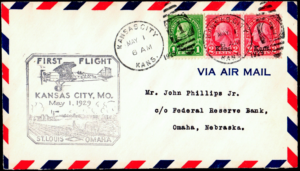
The area of collecting air mail first days covers, other flown first days, rate change covers, etc., remains quite active. For the first day cover collector it provides another interesting collecting area; for the first flight collector adding combination first days and early use covers is a great way to broaden the scope.
First day covers are available from numerous sources. The APS Stamps.org StampStore lists 200 US air mail FDC covers; a popular auction site currently has over 7000 listed, with about half US, of which 2000 covers are listed at less than $5.00.
References
US Air Mail FDC’s
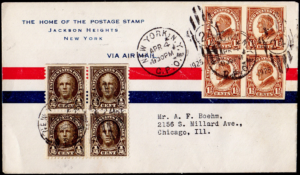
s.
Flown Regular Mail FDC’s
.
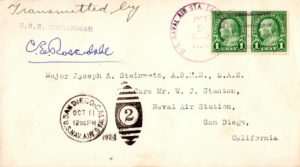
Professor C. R. (Bob) Helms, Ph.D.
In this section we focus on the US rigid airship developed for the Navy in the 1920’s and 1930’s. All four of the US rigid airships, the ZR-1 USS Shenandoah, ZR-3 USS Los Angeles, ZRS-4, USS Akron, and ZRS-5 USS Macon, were Zeppelins, built from modified Zeppelin designs. However, unlike their German counterparts, they were military ships, and not intended for carrying passengers or mail. Except for five flights of the Los Angeles and two flights of the Akron, flown mail is quite rare and scarce. The majority of the covers related to the various flights are commemorative event covers, in some cases with quite beautiful and rare cachets. Many of these covers were postmarked and cacheted on US Navy Ships, making this collecting area of interest to collectors of ship mail.
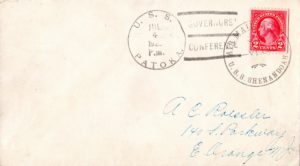
The US rigid airship era discussed here started with the first flight of the Shenandoah on September 4, 1923, and ended with the crash of the Macon of February 12, 1935. Much of the collecting interest spans just this 12 year period, although many commemorative covers have been produced since, especially at the 50th anniversary of various events.
Early US Rigid Airships – the USS Shenandoah ZR-1 and USS Los Angeles ZR-3
The USS Shenandoah was active from 1923 – 1925. was built in Lakehurst, NJ, but crashed on its 57th flight on September 3, 1925. The Zeppelin Corporation built the USS Los Angeles in Germany, originally assigned the LZ-126 designation. The LZ-126 made three flights in Germany prior to the delivery flight to Lakehurst in 1924. The Shenandoah and Los Angeles were operating simultaneously for about one year. However, the supply of helium was insufficient for both ships to be in the air at the same time.
Given that cachet making and event cover collecting did not become popular until well into the 1930’s it is not surprising that few event covers were made to commemorate the various flights of the Shenandoah or the Los Angeles. The flown covers reported are typically rare and scarce. A cov
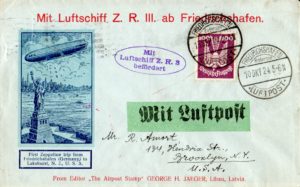
er flown on the Shenandoah is shown (Fig. 1) from the transcontinental flight in October, 1924, from Lakehurst to San Diego (and return). Note, the Lakehurst Naval Air Station postmark and the San Diego Receiver on October 11. The cover also has a backstamp in Fort Worth on October 9th as it made an intermediate stop there. Both flown and event covers (not flown) were prepared for the Shenandoah’s flight to the US Governor’s Conference in Bar Harbour, Maine, in July of 1925. The flown covers are either postmarked in Lakehurst or Bar Habour. We show one of the event covers prepared by A. C. Roessler (Fig. 2).
The delivery flight of the ZR-3 (later Christened the USS Los Angeles) took place on October 12, 1924, from Friedrichshafen to Lakehurst, touching down on the 15th. We show an example of a flight cover for the delivery flight (Fig. 3). It has a September 15, 1924, postmark and an informational postmark on October 10th and is backstamped in New York on the 15th. We show an example of a cover flown on the Los Angeles’ flight to Bermuda on February 20, 1925(Fig. 4). It has an interesting corner card/cachet from A. C. Roessler with an indication of how his name should be pronounced.
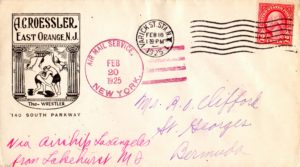
The USS Los Angeles remained active until May, 1932, overlapping operations of the USS Akron by 8 months. Sufficient helium was available so they could be in the air at the same time. We show a flown cover from the USS Akron (Fig. 5) with a combination cachet printed by A. C. Roessler and the purple cachet added by the Post Office Department. We also show the back of the cover (Fig. 6); backstamps provide critical information about the cover’s actual trip. The San Diego backstamp on May 11, 1932, coincided with the arrival of the Akron after her cross-country trip from Lakehurst.
The cover arrived back in New Jersey three days later, transported by other means. The orange cachet also gives an idea of the size of the Shenandoah, Los Angeles, and Akron. The Akron and Macon were both 785 ft. long, almost the length of three football fields, and with much larger diameter at over 130 ft.
The early 1930’s was at the beginning of a major collecting interest in cacheted covers. Mellone’s Ullmann Photo-Encyclopedia lists over 500
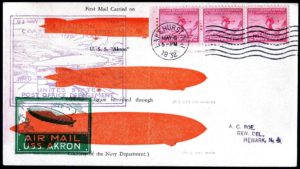
event covers for the USS Akron. When the Akron crashed early in the morning of April 4, 1933, cachet makers produced a large number of covers to mourn the loss. We show one example, with hand painted cachet, signed by Secretary of the Navy Claude A. Swanson and Moody Erwin, one of the survivors of the crash (Fig. 7). The cachet is of the period but was added after the cover was postmarked. The collecting of covers with of the period autographs is quite popular.
Christened just one month after the crash of the Akron, the USS Macon was active for two years before it also crashed – this time in the Pacific. The Macon did not fly any official mail, but the crew did carry mail from time to time. These covers are quite rare and scarce. We show one example (Fig. 8) from the delivery flight of the Macon from Akron to Lakeet makers also made many event covers for the USS Macon – over 3000 varieties exist. Given the numerous exercises of the Macon with regular Navy ships, the mail clerk cancelled a number of these on board ships. We show an example (Fig. 9) from the Cruiser USS Northampton (CA-26). Note the double cachet by W. G. Crosby; smaller #6¾ size covers were also made with the green and black cachets. The covers are signed by the pilot of one of the Northampton scout planes (she carried four planes and two catapults) and Leo Miller, the mail clerk, who was instrumental in preparing covers from the Northampton.
Collecting the US Rigid Airship covers can be a lot of fun and intersects the space between air mail, Zeppelins, and US Navy ship’s covers. The Mellone’s Photo Encyclopedia of USS Akron and Macon Event covers is a great place to start and has over 2500 listings. The Michel Specialized Catalog has a listing of many of the covers flown on all four airships. Other references are listed below. There are a number of ASDA members who specialize in these covers. A popular auction site has over 1200 covers listed at a median price of $20; 350 sold in the last 90 days at a median price of $7.00
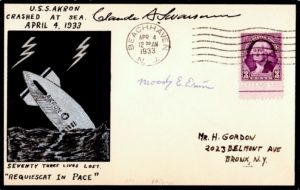
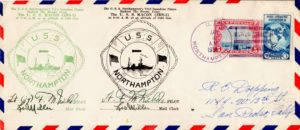
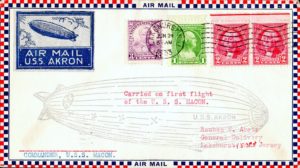
| Previous Editions | Useful Links | Section Contact |
|---|---|---|
| Mellone’s USS Akron and Macon | C. R. (Bob) Helms, Ph.D | |
| Michel Zeppelin Specialized Catalogue 2003 | ||
| airships.net. | ||
| blimpinfo.com | ||
| www.nihs.com | ||